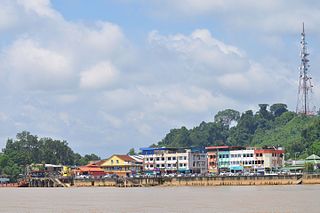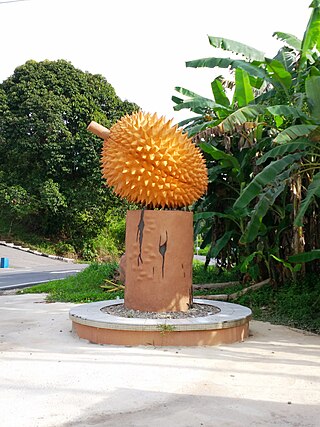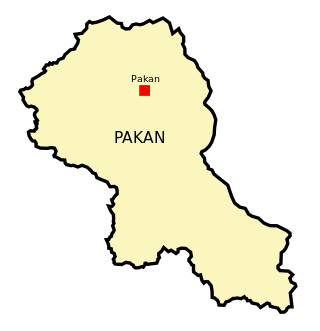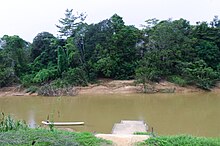
Sibu is a landlocked city located in the central region of Sarawak, Malaysia. It serves as the capital of Sibu District within Sibu Division and is situated on the island of Borneo. Covering an area of 129.5 square kilometres (50.0 sq mi), the city is positioned at the confluence of the Rajang and Igan Rivers, approximately 60 kilometres from the South China Sea and 191.5 kilometres (119 mi) north-east of the state capital, Kuching.

Sarikei is a town, and the capital of Sarikei District in Sarikei Division, Sarawak, Malaysia. It is located on the Rajang River, near where the river empties into the South China Sea. The district population was 56,798.

The Rajang River is a river in Sarawak, northwest Borneo, Malaysia. The river originates in the Iran Mountains, flows through Kapit, and then towards the South China Sea. At approximately 565 km long (351 mi), the river is the seventh-longest in Borneo and the longest in Malaysia.

Kapit is a town and the capital of Kapit District in Kapit Division, Sarawak, Malaysia on the south bank of the Rajang River. The district comprises 15,595.6 square kilometres and as of 2020, it has a population of 65,800.

Song is a town, and the capital of the Song District in Kapit Division, Sarawak, Malaysia. The district population was 20,046 according to the 2010 census. Song is situated by the banks of the Katibas River, a tributary of the Rajang River. It is an important stopover for river traffic going up the Rajang River.

Sibu Division is one of the twelve administrative divisions of Sarawak, Malaysia. It has a total area of 8,278.3 square kilometres, and is the third largest division after Kapit Division and Miri Division.

Kanowit is a town and the capital of Kanowit District, Sibu Division, Sarawak, Malaysia, comprising 2,253.5 square kilometres. As of 2010, Kanowit's population is 28,985. It is built on the mouth of Kanowit River at the bank of Rajang River, approximately 174 kilometers from the coast of South China Sea. It takes 45 minutes to reach the town by land transport and an hour by boat from Sibu. The main ethnic groups are Iban, Chinese, Malay, and Melanau.

Betong Division, formed on 26 March 2002, is one of the twelve administrative divisions in Sarawak, Malaysia. Formerly part of Sri Aman Division, Betong is in the Saribas area. It has a total area of 4,180.8 square kilometres, and is the smallest of the administrative divisions of Sarawak.

Betong is a town in Betong Division in Sarawak, Malaysia, lying in the Saribas area. It was formerly under the Sri Aman district. Betong is located between three main rivers, Batang Lupar, Batang Saribas and Batang Kelaka, and covers an area of 4,180 km2.

Sarikei Division is one of the twelve administrative divisions in Sarawak, Malaysia. Formerly part of the Third Division, which included Sibu and Kapit, Sarikei Division has a total area of 4,332.4 square kilometres (1,672.7 sq mi), and is the second smallest of the administrative divisions of Sarawak.

The Meradong District is located in Sarikei Division, Sarawak, Malaysia. The capital of Meradong District is Bintangor, Sarawak. The official census in 2006 stated Meradong as covering 719 sq km, making it the smallest district of Sarawak in terms of geographic area, and the district population from the 2010 National Census was 28,672. It is situated nearby Sarikei District.

Bintangor is a town, and the capital of the Meradong District in Sarikei Division, of Sarawak, Malaysia. Situated along the Rejang River, Bintangor was an express boat services hub connecting between, Sarikei town and Sibu city in the 1970s up to the early 1990s. As road connections between these towns became a more prominent mode of transport, the waterway of the town died down.

Pakan is a small town in Pakan District, Sarikei Division, Sarawak, Malaysia. The district population estimates was 17,600.
Wahab bin Dolah is a Malaysian politician. He was the Member of the Parliament of Malaysia for the Igan constituency in Sarawak, representing the United Traditional Bumiputera Party (PBB) in the ruling Barisan Nasional coalition.

Selangau, Sarawak, is a small town located by the Pan Borneo Highway. It is also located by Batang Mukah, a river which flows to the South China Sea. It is located approximately 74 km (46 mi) from Sibu city, 84 km (52 mi) from Mukah town and 134 km (83 mi) from Bintulu town. Selangau town is the administrative centre for the Selangau District.

Pakan District is an administrative district in Sarikei Division, Sarawak, Malaysia, covering an area of 924.6 square kilometres (357.0 sq mi). The town of Pakan is the capital of the Pakan district, located 45 km from the town of Sarikei.

Julau is a district, in Sarikei Division, Sarawak, Malaysia.

Tebedu District is a district in the state of Sarawak, Malaysia. It is a part of Serian Division that consists of Serian, Siburan, and Tebedu districts. Before this, Tebedu District was a sub-district under Serian District which was then fully upgraded to a district in its own right. The majority of the population of this district is from the Bidayuh ethnic group.


























